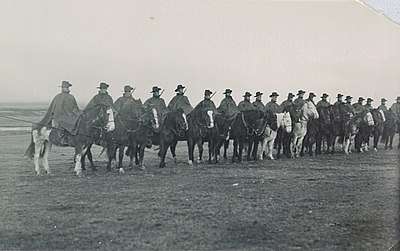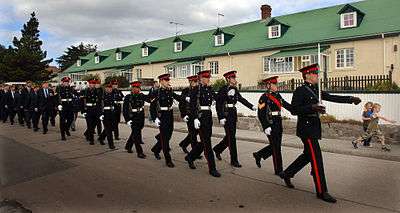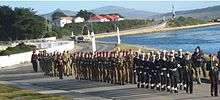Falkland Islands Defence Force
The Falkland Islands Defence Force (FIDF) is the locally maintained volunteer defence unit in the Falkland Islands, a British Overseas Territory. The FIDF works alongside the military units supplied by the United Kingdom to ensure the security of the islands.
| Falkland Islands Defence Force | |
|---|---|
.svg.png) Badge of the Falkland Islands Defence Force | |
| Active | 1892–1982 1983–present |
| Country | Falkland Islands, United Kingdom |
| Type | Military reserve force |
| Role | Light Infantry with additional roles |
| Size | One Company 2 Permanent Staff Personnel ~100 Primary Reserve Personnel ~100 Secondary Reserve Personnel |
| Garrison/HQ | Port Stanley |
| Nickname(s) | Falklands Army |
| Battle honours | Falklands War |
| Commanders | |
| Commanding Officer | Major Justin McPhee[1] |
History
Origin
In 1847, Lieutenant Richard Clement Moody, Governor of the Falkland Islands, formed the Falklands' militia force, consisting of two infantry platoons, and a combined mounted and artillery corps.[2] A volunteer unit was reformed in 1854, during the Crimean War, to guard against possible aggression by the Russian Empire.[3] Not given an official title, the unit was sometimes known as the Stanley Volunteers.
In 1892, a steamer owned by one of the belligerents involved in the Chilean Civil War docked at Port Stanley.[2] Ostensibly there to carry out repairs to its engines, the presence onboard of 200 armed soldiers was considered a security threat, and Governor Sir Roger Goldsworthy therefore ordered that an armed volunteer force be formed. The first draft of men of the Falkland Islands Volunteers were sworn in at a ceremony at the Falkland Government House, in June 1892.[2]
World War I

During the First World War, members of the Volunteers were mobilised to man military outposts around the Islands, while 36 Falklanders enlisted in the British armed forces, 10 of whom subsequently lost their lives during the war.[3] In 1919 the Falkland Island Volunteers were stood down and were subsequently renamed as the Falkland Islands Defence Force.[2] The FIDF was mobilised again during the Second World War, manning defensive outposts around the Islands. At this time, a mounted rifles unit was raised.[2]
World War II
On 27 September 1939, thirty-three men arrived from Argentina in a group called the "Tabaris Highlanders." Gathered from the Anglo-Argentine community, they were supposed to defend the islands from a German attack. Six of these volunteers were rejected on medical and other grounds and returned to Buenos Aires almost immediately. The "commanding officer," a Major Morrough, was one of those rejected. The remainder were enrolled in the Falkland Islands Defence Force, with Ronald Campbell made sergeant as commander and Thomas Dawson Sanderson made corporal. Many were rugby players, including Sanderson, who was president of a rugby club.[4]
The men left the Islands on 8 December 1939, once the immediate danger of attack from German raiders was judged to have receded. During this time the Highlanders dug out gun pits, embankments, and other protection from a possible German naval attack. Twenty-two of them applied from Stanley to join the British Forces.[4]
During the war around 150 islanders joined the British armed forces, of which 26 were killed in action.[2] In June 1946 a section of the FIDF took part in the Victory Parade in London.[2]
After the end of the war, the presence of Royal Marines as part of the Islands' defence led to the FIDF adopting RM dress and drill styles. On 28 September 1966,[5] 19 members of an Argentine extremist group staged a symbolic invasion of the Islands by landing a DC-4 on Stanley Racecourse, in one of the first significant hijacking incidents; the extremist group called this action Operation Condor. There, they took four islanders hostage. The FIDF, alongside the Royal Marines, contained the situation and the group surrendered without casualties. Following this, the FIDF was on heightened alert until February 1967.[2]
Falklands War
On 1 April 1982, alongside the Royal Marines party, the FIDF was mobilised to defend the Islands from the Argentine invasion. Of its approximately 120 men only 23 turned out.[6] The following day, Sir Rex Hunt ordered them to surrender. The Argentines confiscated all of the FIDF's equipment and declared them to be an illegal organisation. For the duration of the war, some members of the FIDF were kept under house arrest at Fox Bay until the Argentine surrender. The FIDF was reformed in 1983.[2]
Terry Peck, a former member of the Defence Force, spied on Argentine forces in Stanley, then escaped to become a scout for the 3rd Battalion, Parachute Regiment, with which he fought at the Battle of Mount Longdon.[7]
Personnel

The Falkland Islands Defence Force meet once a week for training, with various extended training weekends throughout the year. Soldiers of the Falkland Islands Defence Force conduct training patrols with soldiers from the British garrison on the islands as well as acting as "enemy" forces against British soldiers in training exercises.[8]
FIDF soldiers also provide search and rescue and mountain rescue services across the islands.[2][9] They have been trained by the Royal Navy to operate Oerlikon 20 mm cannons and conduct boarding operations of vessels to fulfill a fisheries protection role for the Falkland Islands Government.[10][2][9]
Major Peter Biggs (Retd)[11] served with the FIDF for 35 years and was the Commanding Officer from 2002 to 2016.[1]
Equipment
Equipment includes:
Funding

The Falkland Islands Defence Force today is funded entirely by the Falkland Islands government and has an annual budget of £400,000.[15]
Organisation
The FIDF is organised as a light infantry company with additional roles. It is manned entirely by the local population, following British Army doctrine, training and operations. New recruits go through a 12-week training program.[16] In an agreement with the British Ministry of Defence, a Royal Marines Warrant Officer Class 2 is seconded to the Force as a Permanent Staff Instructor.[2]
Insignia
Cap Badge

The cap badge is the badge of the FIDF cast in metal. It shows the escutcheon party per bend, with a Sea Lion in the lower half, and the rear end of an old sail ship in the upper half, surrounded by the slogan "Desire the Right". This badge was formerly the Coat of arms of the Falkland Islands from 1925–1948.[17]
Stable Belt
Alliances
See also
- Military of the Falkland Islands
- Royal Bermuda Regiment
- Royal Gibraltar Regiment
- Royal Montserrat Defence Force
- Royal Hong Kong Regiment (defunct)
References
- Merco Press (26 October 2018). "Falkland appoints new Officer Commanding the Islands' Defense Force". Retrieved 7 February 2019.
- Falkland Islands Government. "The Falkland Islands Defence Force – a brief history". Retrieved 7 February 2019.
- Falkland Islands Information Portal. "Falkland Islands Defence Force: 150 years of Voluntary Service". Archived from the original on 27 April 2006. Retrieved 19 June 2006.
- Dictionary of Falklands Biography 1592 - 1981; TABARIS HIGHLANDERS (1939) Archived 2 December 2008 at the Wayback Machine, retrieved 10 September 2009
- ASN Aircraft accident Douglas DC-4 LV-AGG Port Stanley
- M. Hastings, S. Jenkins "The Battle for the Falklands", W.W.Norton & Co., London & New York, 1983, Chapter 5, page 72
- "Obituary: Terry Peck". The Telegraph. 6 January 2007. Retrieved 13 October 2019.
- "View from the Falklands: The other British isles". Prospect Magazine. 11 April 2017. Retrieved 13 October 2019.
- Falkland Islands Government. "The Role of The FIDF". Retrieved 7 February 2019.
- Time Cooper (18 December 2017). "Everything You Need To Know About British Forces In The Falklands". Forces Network. Retrieved 11 May 2017.
- BBC News (18 February 2010). "'We always feel threatened by Argentina'". Retrieved 11 May 2017.
- "Special Forces (Land) (Falkland Islands), Amphibious and special forces". Jane's Amphibious and Special Forces. 25 November 2010. Archived from the original on 15 August 2011. Retrieved 28 May 2018.
- https://www.facebook.com/2094635694139862/posts/over-the-last-few-weeks-all-ranks-have-been-training-on-the-l85a2-rifle-and-toni/2299255450344551/
- https://www.facebook.com/permalink.php?story_fbid=2411180652485363&id=2094635694139862
- The Times Article, March 6th 2010, retrieved 23 July 2011
- Hannah Smithson (30 September 2013). "Falkland Islands Defence Force new recruits start training". Retrieved 7 February 2019.
- Mathieson, Ian (2003). "Falkland Islands/Islas Malvinas". Americas Review 2003-2004. Kogan Page. pp. 316–21. ISBN 9780749440640. Retrieved 1 February 2013.
External links
| Wikimedia Commons has media related to Falkland Islands Defence Force. |
- Official website

- BBC News (11 June 2007). "Audio slideshow: Island defenders". Retrieved 11 June 2007.